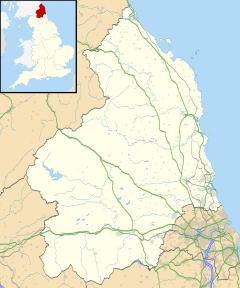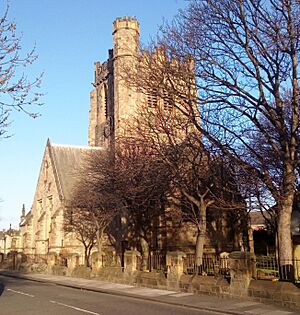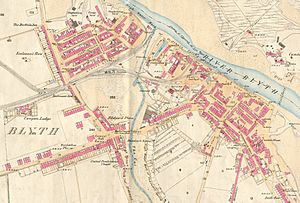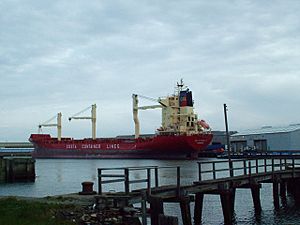Blyth, Northumberland facts for kids
Quick facts for kids Blyth |
|
|---|---|
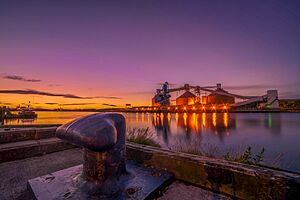 Blyth Harbour- July 2016 by local photographer Kris Hodgetts |
|
| Population | 39,731 (2021 Census) |
| OS grid reference | NZ310814 |
| • London | 300 miles (480 km) SSE |
| Civil parish |
|
| Unitary authority |
|
| Ceremonial county | |
| Region | |
| Country | England |
| Sovereign state | United Kingdom |
| Post town | BLYTH |
| Postcode district | NE24 |
| Dialling code | 01670 |
| Police | Northumbria |
| Fire | Northumberland |
| Ambulance | North East |
| EU Parliament | North East England |
| UK Parliament |
|
Blyth is a port and seaside town in southeast Northumberland, England. It sits on the coast, south of the River Blyth. In 2021, about 39,731 people lived there. This was a 6% increase from 2011.
The port of Blyth has been around since the 1100s. However, the modern town really started to grow in the early 1700s. The main jobs that made the town rich were coal mining and shipbuilding. The salt trade, fishing, and railways were also important. Most of these old industries are gone now. But the port is still busy, bringing in paper and wood pulp from Scandinavia for newspapers in England and Scotland.
When its main industries closed, Blyth faced tough times. But since the early 1990s, the town has been rebuilt and improved. The Keel Row Shopping Centre opened in 1991, bringing big shops to Blyth. This helped make the town centre lively again. The market area has also been updated to attract more businesses.
The Quayside, where ships used to load, has also been changed. It's now a peaceful open space with a sculpture that remembers the old industries. Across the river, you can see the nine wind turbines of the Blyth Harbour Wind Farm. These were built in 1992. In 2000, two more turbines were added about 1 kilometre (0.6 miles) out at sea. These were the first offshore wind turbines in the UK! All these older turbines have now been removed. A newer wind farm with five turbines started working further out at sea in 2017.
Blyth is also home to the football club Blyth Spartans. They are famous for their amazing "giant-killing" wins in the FA Cup back in 1978.
Contents
History of Blyth
The name Blyth first appeared in 1130 as Blida. It comes from the river Blyth. The river's name means 'gentle' or 'merry' in Old English. The town was sometimes called Blithmuth in the 1200s. If that name had stuck, it might be called "Blythmouth" today, like Tynemouth.
We don't know much about the very early days of Blyth. The oldest things found by archaeologists include an antler hammer from the late Neolithic or early Bronze Age. Human skulls, a spearhead, and a sword from the Bronze Age were found in the river in 1890. A bronze axe was found in 1993, and a dagger in Newsham. There's no strong proof of Roman people living here, but some old maps show what might have been a Roman camp. A Roman coin was found during digging for a dry dock, and four more were found in an air raid shelter.
Between the 1100s and 1700s, there were small settlements and some industry in the area. The main jobs were coal mining, fishing, and trading salt. Shipbuilding started here in 1748.
The modern town of Blyth began to grow in the early 1700s. The land was once owned by the Earls of Derwentwater. But in 1715, the Earl lost his land to the King. In 1723, Matthew White and Richard Ridley bought the land. Before this, most port activities were on the north side of the river. But White and Ridley built the first new quays (docks) and houses on the south side. From then on, the port started to do very well. By 1730, Blyth harbour had a coal dock, a place for ships to drop off heavy material (ballast), a pilot's watch house, and a lighthouse. In 1765, the first breakwater (a wall to protect the harbour) was built.
Deep coal mines were dug in 1796 and 1804. By 1855, a quarter of a million tons of coal were shipped from Blyth. This grew to three million tons by 1900! The salt trade, however, did not survive. It was heavily taxed, especially during the Napoleonic Wars. Even after the tax was removed in 1825, the industry died out. Blyth's salt industry, which once had 14 salt pans and exported over 1,000 tons of salt a year, closed in 1876.
In 1887, William Morris, a famous poet and designer, spoke to striking miners in Blyth's market square. He talked about how workers were many and bosses were few.
From the mid-1800s, several important things happened that helped Blyth's port grow fast. First, a railway line was built in 1847, connecting Blyth to coal mines. In 1853, the Blyth Harbour and Docks Board was created. Then, in 1858, a law was passed that allowed the harbour to be deepened. In 1882, the Blyth Harbour Commission was formed. This led to new coal loading docks and the building of the South Harbour.
As trade grew in Blyth, so did the number of people living there. New areas like Cowpen Quay and Waterloo started to be built in the early 1800s. Between the 1850s and 1890s, many houses were built. Blyth railway station, first built in 1847, was moved and rebuilt in 1896 to handle more goods and passengers. In the 1890s, "the Slake," a tidal inlet, was filled in. This inlet used to separate Blyth from Cowpen. Once it was filled, the two areas joined, and the town started to look like it does today. The town kept growing in the 1900s, with lots of new houses built.
Industry in Blyth was at its busiest in the first half of the 1900s. At this time, it had one of the biggest shipbuilding yards on the North East coast. It had five dry docks and four places to build ships. During World War I and World War II, Blyth shipyards built many ships for the Royal Navy. This included the first aircraft carrier, HMS Ark Royal in 1914. Blyth was also a submarine base during both wars. Blyth was bombed several times during World War II. Landmarks like the railway station and the Wallaw Cinema were damaged. By 1930, the port of Blyth was sending out 5.5 million tons of coal. By the early 1960s, it reached its highest point with over six million tons. Blyth A and Blyth B power stations, known together as Blyth Power Station, opened in 1958 and 1962.
In the 1960s, Blyth started to decline. The railway into Blyth closed in 1965. In 1966, the shipyards closed because of economic problems. As people used less coal, many coal mines in the area closed. By the 1980s, only Bates' Pit was left, and it closed in 1986. In 2002, Blyth Power Station closed and was taken down in stages. Its four tall chimneys were knocked down on 7 December 2003.
How Blyth is Governed
From the early 1700s until 1900, the land south of the River Blyth was called South Blyth. It was managed by the Parish Council. Over time, different local councils were formed. In 1906, South Blyth joined with Cowpen to form the Blyth Urban District Council. In 1922, Blyth became a Municipal Borough Council. This council lasted until 1974.
Blyth was the main town for the borough of Blyth Valley until 2009. Now, the whole county of Northumberland has one main council. Blyth is part of the Blyth and Ashington area for the UK Parliament. It is represented in the House of Commons by Ian Lavery from the Labour Party.
Blyth is also twinned with Solingen, a town in Germany.
Geography of Blyth
Blyth is on the coast of North East England. It's south of the River Blyth. It is about 21 kilometres (13 miles) northeast of Newcastle upon Tyne. To the north of the river are villages like East Sleekburn and Cambois. To the south are New Hartley and Seaton Sluice. Some of Blyth's suburbs, like Newsham and Cowpen, are even older than the town itself. Most houses in these areas were built in the 1800s and 1900s.
The land in Blyth is mostly made of sandstone, mudstone, and coal, covered by clay. In October 2023, the sand at Blyth promenade beach was washed away by Storm Ciarán.
Weather in Blyth
The weather in Northumberland is usually cool and dry. Extreme weather like floods or heatwaves is rare. The average temperatures are a bit lower than the rest of the UK, and it gets less rain. For example, Blyth gets about 651 millimetres (26 inches) of rain each year, while England as a whole gets about 838 millimetres (33 inches).
Getting Around Blyth
The main road to Blyth is the A189 Spine Road. You can get to it from the A1 or A19. The A193 goes through Blyth and connects to Bedlington and North Tyneside.
Blyth has a bus station in the town centre. Buses are run by Arriva North East and Go North East. They offer regular services to Newcastle and other towns.
Blyth does not have passenger train services right now. The closest station is Cramlington, about 8 kilometres (5 miles) away. The old Blyth railway station closed in 1964. However, there are plans to reopen a passenger train service to Newsham by 2024 as part of the Northumberland Line project.
Port of Blyth

The Port of Blyth was first mentioned in 1138. At that time, monks exported salt that they made using local coal. Coal exports started in the 1300s. By 1609, 21,571 tons of coal were shipped from Blyth. The first large quay (dock), Bishop's Quay, was built by 1682. But the port wasn't deep enough then, so smaller boats had to carry goods to bigger ships further out at sea. By 1730, there were special docks for coal and for ships to drop off heavy material. By 1765, the port had a pilot house and a lighthouse. The High Lighthouse worked until 1984.
The port grew a lot in the 1800s. A steam tugboat was bought in 1819, and the breakwater was rebuilt in 1822. By then, three shipbuilding yards had also started. The Blyth and Tyne Railway, built from 1849, helped coal shipments grow quickly. They reached 200,000 tons per year. The Blyth Harbour Commission was formed in 1882. This allowed more money to be raised to build the South Harbour.
By the 1900s, Blyth became Europe's largest coal export port. It exported 5.5 million tons per year by the late 1930s. Shipbuilding also grew. The Blyth Shipbuilding Company was founded in 1883. They built cargo ships and coal ships. In 1914, the British Navy bought a cargo ship being built there and turned it into the Navy's first seaplane carrier, Ark Royal. The company built many ships for World War II, including Audacity. The shipbuilding yard closed in 1967. Later, the yards were taken down in the late 1980s to make space for storing paper and timber.
After World War II, Blyth remained a major port through the 1960s, exporting over 6 million tons of coal each year. However, with the closure of Blyth's last shipbuilder in 1966, the port started to shrink. Some jobs were created by the building of the coal-fired Blyth Power Station on the north bank of the river. The power station's four tall chimneys were a famous sight for over 40 years. They were taken down in 2003.
Today, the Port of Blyth handles up to 1.5 million tons of cargo. This includes containers, roll-on/roll-off cargo (where vehicles drive directly onto the ship), and materials for making aluminium. It also handles different types of stones and metals. A shipping service connects the port to the Netherlands twice a week, linking Blyth to Germany, Belgium, and France.
Blyth's Economy
Jobs and Businesses
With the coal mining and shipbuilding industries closing, Blyth is now largely a town where people live and travel to work in Newcastle and North Tyneside. However, its port is still a big industry. It handles over 1.5 million tons of cargo every year. Its main goods are wood products like paper and timber, and containers. It also imports materials for making aluminium. The port is run by Port of Blyth, which is a trust port. This means any money it makes is put back into improving the port.
Energy
Renewable Energy
Several renewable energy projects have been set up in Blyth. In 1992, the Blyth Harbour Wind Farm was built along Blyth's East Pier. It had nine wind turbines and could power over 1,500 homes. In 2000, the Blyth Offshore Wind Farm was added, with two turbines 1 kilometre (0.6 miles) out at sea. These were the UK's first offshore wind turbines. They were also the largest in the world when they were installed. These older turbines were removed in 2019. However, 5 new, larger wind turbines were installed in 2017. These turbines produce enough power for 36,000 homes.
The National Renewable Energy Centre (Narec) is based at the Quayside. It was set up in 2002 to develop and test new energy technologies. This helps us move towards a low-carbon economy (using less fossil fuels).
Future Plans
In 2020, Blyth was chosen for a new battery factory called Britishvolt. Plans for this huge factory, which would create 3,000 jobs, were approved in 2021. It was meant to make lithium-ion batteries for cars. The UK government even invested money in it. However, the project faced problems, and the factory was not built. In 2024, the site was bought to build a data centre instead. This new plan could bring up to £10 billion in investment and create 1,200 long-term construction jobs.
Town Improvements
New shops in the town centre have also helped make Blyth better. The Keel Row Shopping Centre, opened in 1991, brought many big shops to the town. The market, held three times a week, was also updated in 2009. It now has new paving, seating, and a water feature. The main artwork is a 7.5-metre (25 ft) stainless steel column called Hyperscope. It represents the town's coal mining past and its history as a submarine base. These improvements aim to attract more people and businesses to Blyth.
Jobs in Blyth
When Blyth's heavy industries (like coal and shipbuilding) closed, many jobs for men were lost. The town then saw a shift towards lighter industries, often employing more women. These new businesses were based in trading estates. In 2001, many people in Blyth worked in manufacturing, retail, health, and social work.
People of Blyth
Blyth is the largest town in Northumberland. In 2011, it had a population of 39,731 people. Most residents (97.3%) were white. About 62.6% of people said they were Christian, and 29.7% said they had no religion.
Education in Blyth
Blyth has a two-tier school system, meaning it has primary schools and secondary schools. The town has nine primary schools and two secondary schools, including The Blyth Academy. Until 2009, it also had middle schools, but these closed when Northumberland changed to the two-tier system.
The Blyth Academy opened in 2000. It can hold 1,450 students and also offers classes for adults. Northumberland College has a centre in Blyth, and there's a public library with many local history resources.
Bede Academy, a school for children aged 3 to 18, opened in 2009. It focuses on engineering and business, which fits with Blyth's industrial past. In October 2022, the school was featured on the BBC show "We are England - Educating Blyth." The show followed students trying to become future engineers.
The Dales School is a special needs school. In 2019, Blyth won money to open an 80-place special school for children with specific learning difficulties. In October, Blyth also received funding for mental health support teams in schools.
Media in Blyth
Local news and TV shows for Blyth are provided by BBC North East and Cumbria and ITV Tyne Tees.
Local radio stations include BBC Radio Newcastle, Capital North East, and Koast Radio, which is a community station on 106.6 FM.
The town has local newspapers like the Northumberland Gazette and the Evening Chronicle.
Fun and Leisure in Blyth
Events and Places to Visit
Since 2014, Blyth Town Council has held the Northumberland Live Festival every June. It takes place on a field near the North Sea beach. The festival has music, fairground rides, and entertainment for children. Famous bands like The Lightning Seeds and Scouting for Girls have played there. Up to 18,000 people have attended!
The Blyth Town Christmas Fayre is also held in the market place. It has similar family entertainment. Near the town centre is the Phoenix Theatre, a small theatre with 299 seats. It shows professional performances and also works with local amateur groups. Blyth once had four cinemas, but the last one, the Wallaw, closed in 2004.
Sports and Outdoor Activities
The town is home to the football club, Blyth Spartans. They were founded in 1899 and play their home games at Croft Park. They are famous for their "giant-killing" wins in the FA Cup, especially in the 1977–78 season when they reached the fifth round. Blyth also has another football club, Blyth Town, and clubs for cricket and rugby.
Blyth Sports Centre has many facilities, including two swimming pools, a sports hall, squash courts, a gym, saunas, and an outdoor skate park. Blyth Golf Club has an 18-hole course. The Royal Northumberland Yacht Club is based in the South Harbour. It offers sailing and powerboating lessons for its members.
Parks and Green Spaces
Ridley Park was opened on 27 July 1904. In 2005, it was improved with a children's water play area and better play facilities. The Quayside, once a busy industrial area, is now a clean and peaceful place. It has the "Spirit of the Staithes" sculpture and "solar sound posts." These posts play stories about the port told by local people when you get close to them.
Blyth's biggest natural open space is its beach and sand dunes. They stretch from the river mouth to Seaton Sluice. The dunes were made a Local Nature Reserve in 2003. They are important for their many different plants, butterflies, moths, and birds. They are also one of only two places in the country where both types of banded land snail (Cepaea nemoralis and Cepaea hortensis) live.
Landmarks and Interesting Places
| Construction | stone (later additions in brick) |
|---|---|
| Tower shape | cylindrical tower and no lantern |
| Height | 18.74 m (61 ft 6 in) |
The "Spirit of the Staithes" sculpture on Blyth's Quayside was revealed by Princess Anne in 2003. It was created by artist Simon Packard as part of the Quayside's improvements. Standing 15 metres (50 feet) high, it represents Blyth's history as a major coal exporter.
The "High Light" lighthouse is one of Blyth's oldest buildings. It is 18.74 metres (61 feet 6 inches) tall and was built in three stages, starting in 1788. It used to guide ships into the harbour. The lighthouse was turned off in 1985 and is now a protected building.
Before they were taken down, the four chimneys of Blyth Power Station were a famous sight along the coast. They were very tall, with two at 167 metres (548 ft) and two at 137 metres (449 ft). You could see them for many miles.
On the north side of the River Blyth, you can still see the remains of the railway coal docks. These were featured in a chase scene at the end of the 1971 film Get Carter, starring Michael Caine.
Famous People from Blyth
- Mark Knopfler, musician and co-founder of the band Dire Straits
- David Knopfler, rhythm guitarist of Dire Straits, Mark's brother
- Dan Burn, Newcastle United football player
- Macaulay Gillesphey, Charlton Athletic football player
- Jean Heywood, actress


